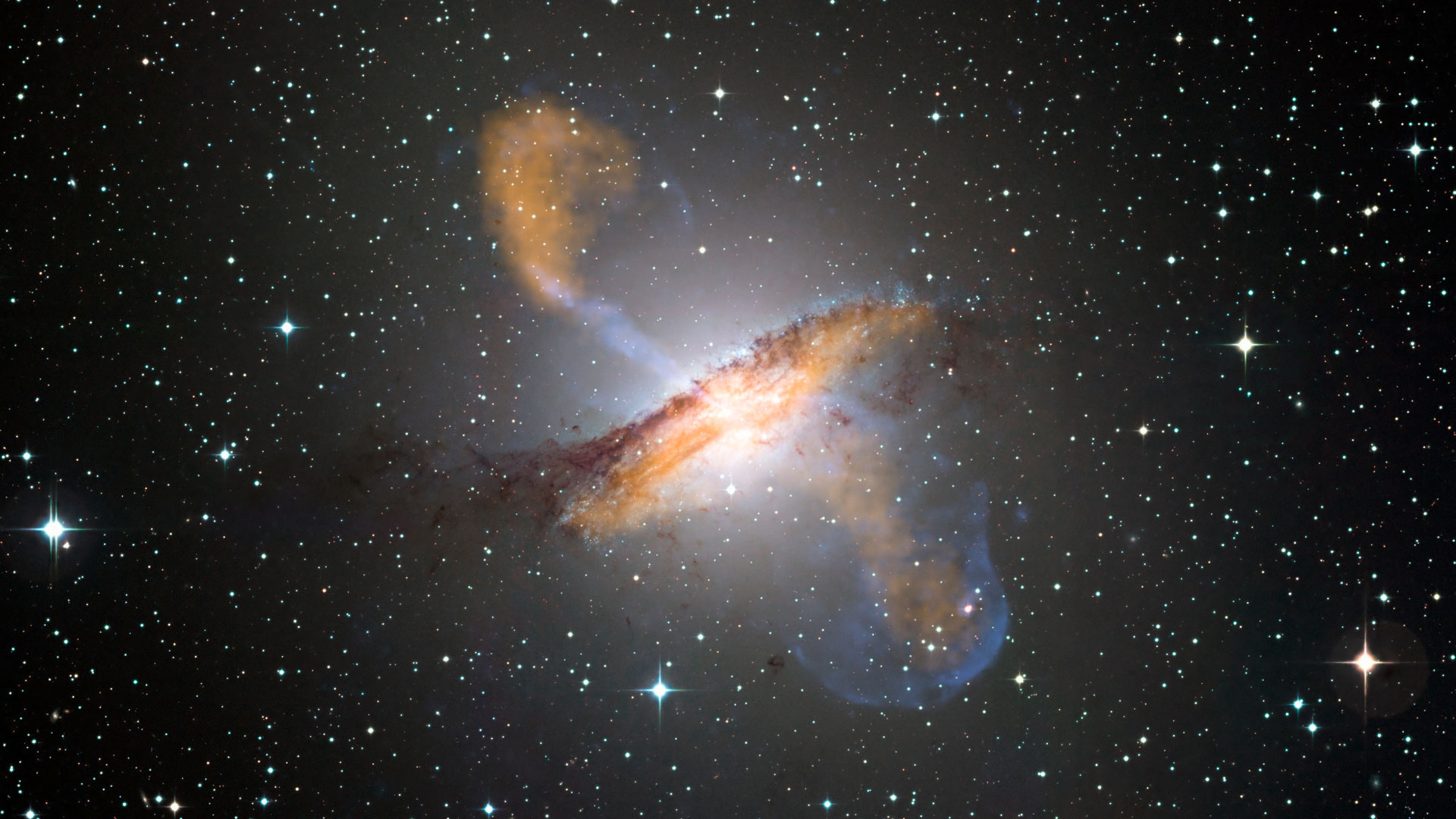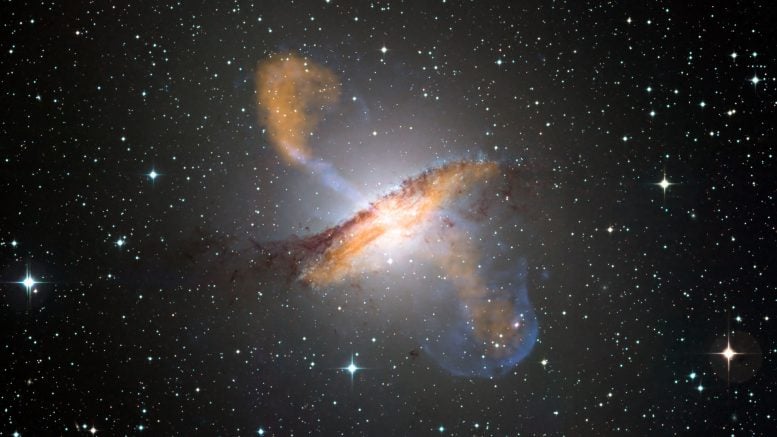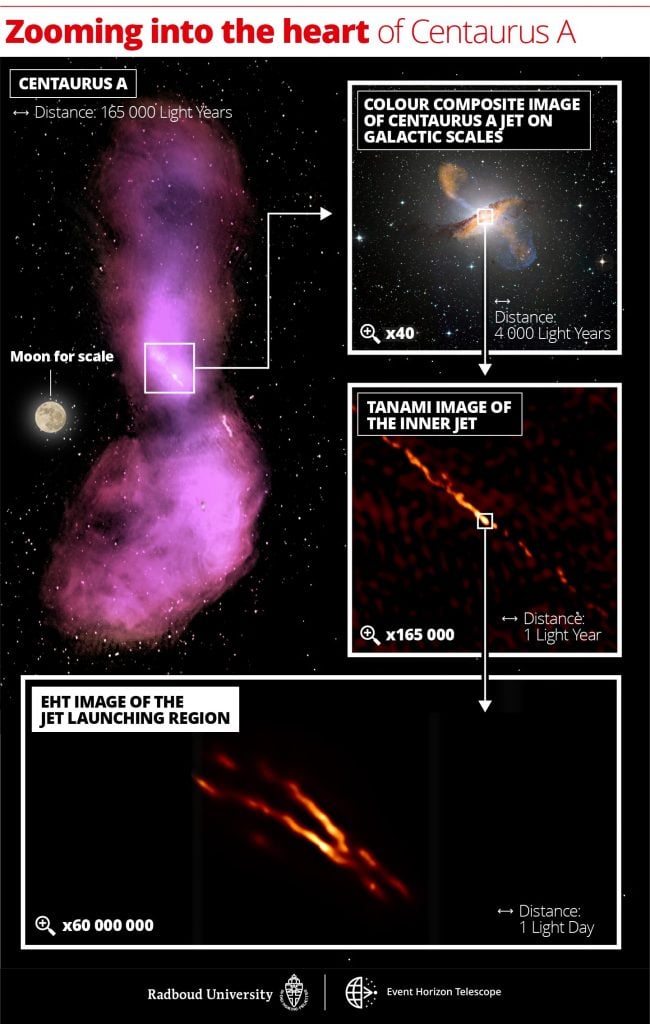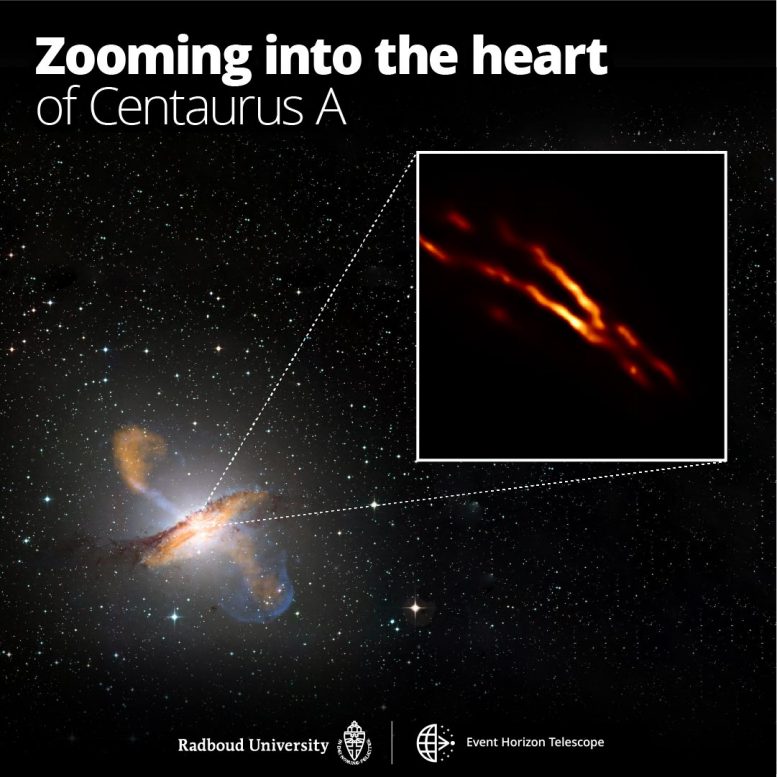
[ad_1]

Composition of Centaurus A images in the optical (ESO / WFI) and X-ray (NASA / CXC / CfA) domain. Centaurus A is a massive galaxy that is in the process of merging with a nearby spiral. Credits: ESO / WFI (Optical), MpIfR / ESO / Apex / A.Weiss et al. (submillimeter); NASA / CXC / CfA / R. Kraft et al. (X-rays)
An international team anchored by the Event Horizon Telescope (EHT) collaboration, known for capturing the first image of a black hole in the Messier 87 galaxy, has now imaged the core of the neighboring Centaurus A radio galaxy in unprecedented detail. Astronomers pinpoint the location of the central supermassive black hole and reveal how a gigantic jet is being born. More remarkably, only the outer edges of the jet seem to emit radiation, which calls into question our theoretical models of jets. This work, led by Michael Janssen of the Max Planck Institute for Radio Astronomy Bonn and Radboud University Nijmegen is published in Nature astronomy today (July 19, 2021).
At radio wavelengths, Centaurus A appears as one of the largest and brightest objects in the night sky. After being identified as one of the earliest known extragalactic radio sources in 1949, Centaurus A has been the subject of extensive studies across the electromagnetic spectrum by a variety of radio, infrared, optical, X-ray observatories. and gamma. At the center of Centaurus A is a black hole with the mass of 55 million suns, which sits just between the mass scales of the Messier 87 black hole (six and a half billion suns) and that at the center of our own galaxy ( about four million suns).

The top left image shows how the jet disperses into clouds of gas that emit radio waves, captured by the ATCA and Parkes observatories. The upper right panel displays a color composite image, zoomed in 40x from the first panel to match the size of the galaxy itself. The submillimeter emission of the jet and the dust in the galaxy measured by the LABOCA / APEX instrument is indicated in orange. The X-ray emission of the jet measured by the Chandra spacecraft is shown in blue. White light visible from stars in the galaxy was captured by the 2.2-meter MPG / ESO telescope. The following panel below shows a 165000x zoom image of the internal radio jet obtained with the TANAMI telescopes. The lower panel represents the new highest resolution image of the jet launch region obtained with the EHT at millimeter wavelengths with a 60,000,000x zoom in telescope resolution. The scale bars shown are displayed in light years and light days. One light year is the distance light travels in one year: about nine trillion kilometers. In comparison, the distance to the closest known star to our Sun is about four light years. A light day is equal to the distance traveled by light in a day: about six times the distance between the Sun and Neptune. Credit: Radboud University; CSIRO / ATNF / I. Feain et al., R. Morganti et al., N. Junkes et al .; ESO / WFI; MPIfR / ESO / APEX / A. Weiss et al .; NASA / CXC / CfA / R. Kraft et al .; TANAMI / C. Mueller et al .; EHT / M. Janssen et al.
In a new paper in Nature astronomy, data from the 2017 EHT observations were analyzed to image Centaurus A in unprecedented detail. “This allows us for the first time to see and study an extragalactic radio jet at scales smaller than the distance light travels in a day. We see up close and personally how a monstrously gigantic jet launched by a supermassive black hole is being born, ”says astronomer Michael Janssen.
Compared to all previous high-resolution observations, the jet launched in Centaurus A is imaged at ten times the frequency and sixteen times sharper resolution. With the resolving power of the EHT, we can now relate the source’s vast scales, which are as large as 16 times the angular diameter of the Moon in the sky, to their origin near the black hole in a region of barely the width of an apple on the Moon when it is projected into the sky. That’s a magnification factor of a billion.
Understanding the jets
Supermassive black holes residing at the center of galaxies like Centaurus A feed on gas and dust attracted by their enormous gravitational pull. This process releases massive amounts of energy and the galaxy is said to become “active”. Most of the material near the edge of the black hole falls off. However, some of the surrounding particles escape moments before being captured and are thrown far into space: jets – one of the most mysterious and energetic features of galaxies – are born.

Highest resolution image of Centaurus A obtained with the Event Horizon telescope above a color composite image of the entire galaxy. Credit: Radboud University; ESO / WFI; MPIfR / ESO / APEX / A. Weiss et al .; NASA / CXC / CfA / R. Kraft et al .; EHT / M. Janssen et al.
Astronomers have relied on different models of the behavior of matter near the black hole to better understand this process. But they’re still not sure exactly how the jets are launched from its central region, and how they can span scales larger than their host galaxies without dispersing. The EHT aims to solve this mystery.
The new image shows that the jet launched by Centaurus A is brighter at the edges compared to the center. This phenomenon is known from other jets, but has never been seen in such a pronounced way before. “Now we are able to rule out theoretical jet models that cannot reproduce this edge brightening. This is a striking feature that will help us better understand the jets produced by black holes, ”says Matthias Kadler, head of TANAMI and professor of astrophysics at the University of Würzburg in Germany.
Reference: July 19, 2021, Nature astronomy.
DOI: 10.1038 / s41550-021-01417-w
Future observations
With the new EHT observations of the Centaurus A jet, the probable location of the black hole has been identified at the jet launch point. Based on this location, the researchers predict that future observations at an even shorter wavelength and higher resolution would be able to photograph the central black hole of Centaurus A. This will require the use of satellite observatories. space.
“These data come from the same observation campaign that delivered the famous image of the black hole in M87. The new results show that the EHT provides a treasure trove of data on the rich variety of black holes and that there is even more to come, ”said Heino Falcke, EHT board member and professor. of astrophysics at Radboud University.
Background information
To observe the Centaurus A galaxy with this unprecedented sharpness resolution at a wavelength of 1.3 mm, the EHT collaboration used very long base interferometry (VLBI), the same technique with which the famous black hole image in M87 was taken. An alliance of eight telescopes from around the world have come together to create the Earth-sized Event Horizon telescope. The EHT collaboration involves more than 300 researchers from Africa, Asia, Europe, North and South America.
The EHT consortium is made up of 13 stakeholder institutes: Academia Sinica Institute of Astronomy and Astrophysics, University of Arizona, University of Chicago, East Asian Observatory, Goethe University Frankfurt, Institute of Millimeter Radio Astronomy (MPG / CNRS / IGN), Large Millimeter Telescope, Max Planck Institute for Radio Astronomy, MIT Haystack Observatory, National Astronomical Observatory of Japan, Perimeter Institute for Theoretical Physics, Radboud University and the Center for Astrophysics | Harvard and Smithsonian.
TANAMI (Tracking Active Galactic Nuclei with Austral Milliarcsecond Interferometry) is a multi-wavelength program for monitoring relativistic jets in active galactic nuclei in the southern sky. This program has been monitoring Centaurus A with VLBI at centimeter wavelengths since the mid-2000s. The TANAMI network consists of nine radio telescopes located on four continents observing at wavelengths of 4cm and 1.3cm.
[ad_2]
Source link